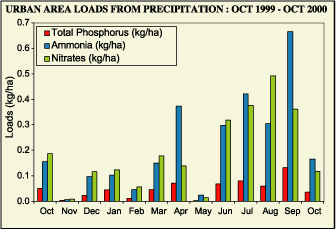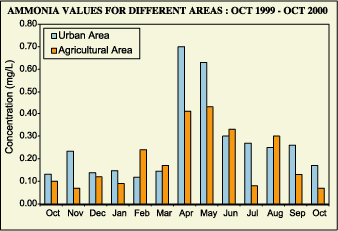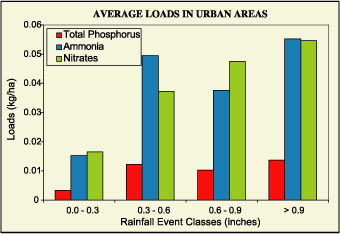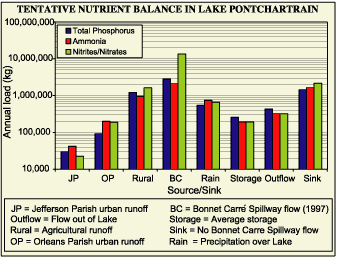| |  |  | | Lake Pontchartrain Atlas: | |  | | |  | | |  | | |  | | |  | | |  | | |  | | |  | | |  | | |  | | Environmental Issues |  | |  | | |  | | |  | | |  |  | |  | |  | | |  |  |  | | | |  | Environmental Issues - Water Quality Contributors: McCorquodale, Barbé, Wang, Carnelos  | | Figure 57: Rainwater samples have been collected since August 1999 from three urban stations in New Orleans and analyzed for water quality parameters: pH, total Kjeldahl nitrogen (TKN), nitrates (NO3-), ammonia (NH3) and phosphates (PO43-). Some of the results are presented here and compared with an agricultural area in Washington Parish. A drought persisted for part of the sampling period with an average annual rainfall of only 44 inches as compared to the normal 62 inches. |  | | Figure 58: NO3- concentrations for urban and agricultural areas were compared for the study period. It was found that these concentrations were higher in the urban area than in the rural area. |  | | Figure 59: Monthly loads from the precipitation in the New Orleans area show a seasonal variation. Due to the drought the loads in November and May were very low and therefore not representative of a normal year. |  | | Figure 60: NH3 concentrations for urban and agricultural areas were compared for the study period. It was found that these concentrations were higher in the urban area than in the rural area. |  | | Figure 61: Parameters for the urban area are shown as a function of different classes of rainfall events. There is a general relationship of decreasing concentrations with increasing amount of rainfall. The wet fall load is a function of the rainfall event classes. The total load increases with increasing rainfall amount but at a decreasing rate. |  | | Figure 62: A tentative nutrient balance in Lake Pontchartrain is given. The wet fall loads of TP, NH3 and NO3- were estimated based on the concentrations measured in this study and adjusted for normal rainfall. This figure shows that rainfall nutrient loads (especially nitrogen) to Lake Pontchartrain are significant compared to other sources such as urban runoff. | « Previous | Next » |

